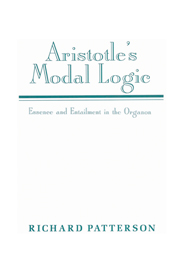Book contents
- Frontmatter
- Contents
- Acknowledgments
- Chapter 1 Introduction
- Chapter 2 The basic modal proposition
- Chapter 3 Syllogisms with two necessity premises
- Chapter 4 Mixed syllogisms: one assertoric and one necessity premise
- Chapter 5 Two-way possibility: some basic preliminaries
- Chapter 6 Two-way possibility syllogisms
- Chapter 7 Aristotle's perfect syllogisms
- Chapter 8 Principles of construction
- Appendix Categorical propositions and syllogisms
- Notes
- Select bibliography
- Index
Chapter 2 - The basic modal proposition
Published online by Cambridge University Press: 14 November 2009
- Frontmatter
- Contents
- Acknowledgments
- Chapter 1 Introduction
- Chapter 2 The basic modal proposition
- Chapter 3 Syllogisms with two necessity premises
- Chapter 4 Mixed syllogisms: one assertoric and one necessity premise
- Chapter 5 Two-way possibility: some basic preliminaries
- Chapter 6 Two-way possibility syllogisms
- Chapter 7 Aristotle's perfect syllogisms
- Chapter 8 Principles of construction
- Appendix Categorical propositions and syllogisms
- Notes
- Select bibliography
- Index
Summary
ARISTOTLE'S GENERAL INTRODUCTION TO THE MODALITIES
In the terminology of ‘A belonging to or applying to B’ (‘A huparchei + dat. B’), dominant in Pr. An. A.4–22, the three basic readings described earlier go as follows: On a de dicto version, Aristotle employs only one copulative expression, huparchei (‘belongs to’, ‘applies to’), but three sentential operators for possibility, necessity, and two-way possibility, each attaching to a plain proposition to form a new modal dictum asserting that the original statement is necessarily true, possibly true (in the sense of not necessarily false), or contingently true (i.e., neither necessarily true nor necessarily false). A modalized predicate reading also calls for the plain copulative expression huparchei, but now with three term-forming operators on terms: n, let us say, which attaches to a given term A to form the term ‘necessarily A’ or ‘necessary-A’ (nA), and the operators p and pp for ‘possibly A’ (pA) and ‘two-way possibly A’ (ppA). Finally, the copulative reading involves no sentential operators and no term-forming operators on terms, but rather four expressions linking Aristotle's general terms: huparchei, ‘belongs to, applies to’; ex anangkēs huparchei, ‘necessarily belongs to’ (symbolized as ‘A N all B’); endechetai (or dunatai) huparchein, ‘possibly applies to’ (A P some B’) or ‘two-way possibly applies to’ (‘A PP all B’). (Negation and quantification pose other questions and may well be, in Aristotle's view, copula operators. The matter is discussed at the end of this section.)
- Type
- Chapter
- Information
- Aristotle's Modal LogicEssence and Entailment in the Organon, pp. 15 - 53Publisher: Cambridge University PressPrint publication year: 1995



